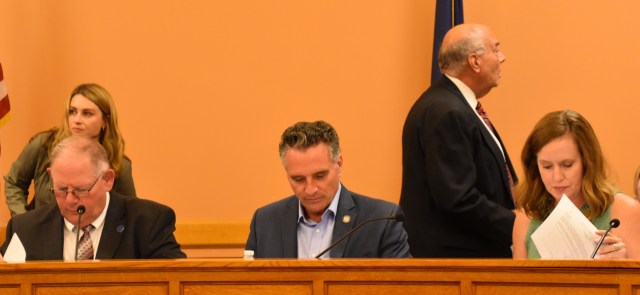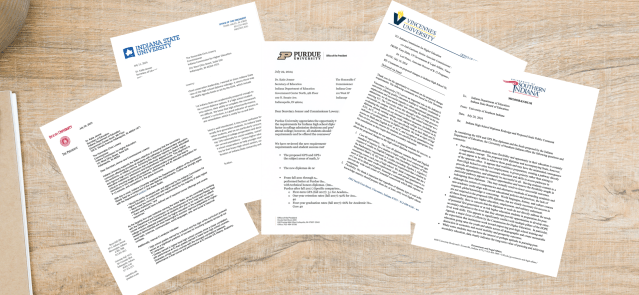Stay ahead of the curve as a political insider with deep policy analysis, daily briefings and policy-shaping tools.
Request a DemoGrand/35th Ave and Indian School Rd project receives final clearance
AZ Supreme Court Strikes Down Union ‘Release Time’ on Taxpayers’ Dime
Special Open Meeting Reminder: Integrated Resource Planning Workshop
- In person : Hearing Room One, 1200 W. Washington St, Phoenix, AZ 85007
- Over the phone: 1-877-309-3457 Passcode: 801972877##
- Watch a livestream online: http://www.azcc.gov/live
Remain to Be Counted
Arizona Treasurer Kimberly Yee Releases the July 2024 Permanent Land Endowment Trust Fund Highlight Report
Attorney General Mayes Issues Statement on Uranium Hauling Across Tribal and Rural Lands
Legislative Coordinating Council renews contract with KanFocus, wants bids for servicer to track 50 states
The Legislative Coordinating Council on Tuesday renewed its bill tracking services contract with KanFocus but also authorized a subcommittee to kick-start a process to solicit bids for providers with the ability to track legislation in all 50 states.
The initial recommendation was to renew the contract with KanFocus for four months to bridge the gap of the expired contract until the start of the 2025 legislative session.
The council reached a compromise with a representative of KanFocus, allowing the contract to be renewed for a year at approximately $108,000, the 2022 price point. KanFocus, which has provided its bill tracking services to the Kansas Legislature for the past 18 years, entered the meeting in search of a rate increase. A two-year extension was also on the table.
Speaker Pro Tem Blake Carpenter, R-Derby, objected to the one-year contract renewal, asserting that legislative staff and revisors immediately need the “best product available” and waiting another year would be counterproductive.
“We should give them as many tools as possible in order to make their jobs as easy as possible,” Carpenter said. “And a search function of the 50 states would make their jobs a whole lot easier if it’s already built into the system they’re using.”
Carpenter added that a company that can track in every state shouldn’t have an issue getting “the software up and running before the 2025 session.”
“I think we are needlessly binding our hands at this point,” he said. “And I think we can, and should, look at what alternatives are out there to get our members the best product available.”
Senate Minority Leader Dinah Sykes, D-Lenexa, indicated she wasn’t that concerned about KanFocus’ ability to track bills beyond Kansas because her office relies on other providers and the Legislative Research Department for bill tracking.
“I do have concern that we say, ‘They have to have access to all 50 states,’” Sykes said of the request-for-proposals document provided by Tom Day, director of Legislative Administrative Services. “My staff works really well with KanFocus.”
Sykes added that she’s heard positive feedback from representatives of other governmental agencies using KanFocus, highlighting the company’s ability to provide real-time updates of legislation.
“They really like [KanFocus] for Kansas specifically because it’s up-to-date as amendments are being included and addressed,” she said. “Whereas some of those other options don’t have access to that in-the-moment [activity].”
Day indicated during the meeting that KanFocus might be equipped to track in all 50 states if it linked its services to other states’ “application programmable interfaces.”
Senate President Ty Masterson, R-Andover, asked if KanFocus would be qualified to submit a contract bid if it’s not equipped to track services in all 50 states. House Speaker Dan Hawkins, R-Wichita, replied that Day’s request-for-proposals memo stipulates the servicer must be able to provide legislation for every state. But Day told State Affairs that his document was merely a draft and “things could change considerably.”
Masterson contended that the expiring contract should be renewed in order to avoid a service interruption but wanted further review of the expanded tracking option via the council’s subcommittee on administration.
Carpenter objected to Masterson’s motion to approve the one-year contract and refer the request for proposals to the subcommittee, asking that it be divided into separate motions. Carpenter argued that the subcommittee is unevenly composed of two Senate members and only one House member. Instead of referring the item to the subcommittee, Carpenter asked that the council resume discussion at a future meeting.
Masterson did not appear amused by Carpenter’s substitute motion, asking if “Robert’s Rule of Order” applied to the request. It was determined that Hawkins, who chairs the council, makes the determination.
“I’ve never been in an LCC meeting that divided a question,” Masterson said.
“The House and Senate should have an equal voice in this matter,” Carpenter said, adding he wants “a place at the table” to engage in dialogue.
Carpenter further noted he is passionate about the issue while also calling for a “legitimate” vetting process.
“I want to make sure that as many people are able to participate as possible, including the folks over at KanFocus,” he said.
Sykes clarified for Carpenter that the subcommittee would merely be reviewing the parameters of Day’s draft proposal, not evaluating and choosing a bid submission, which the council selects.
“This is a way to widen it and see everything that is out there,” Hawkins said.
Carpenter ultimately dissented on the motion to renew the agreement with KanFocus.
Matt Resnick is a statehouse reporter at State Affairs Pro Kansas/Hawver’s Capitol Report. Reach him at [email protected].
Summit Truck Bodies invests $50M in 2nd Wathena plant
Summit Truck Bodies will invest $50 million to build a new plant in Wathena and double the company’s output.
Gov. Laura Kelly announced the plan Wednesday.
The plant will go next to the existing production and warehouse facility, with construction scheduled to be completed in 20 months. The company expects the expansion to create 80 new jobs.
“Summit Truck Bodies’ expansion is proof that our dedicated workforce, quality of life, and central location draw businesses across various industries,” Kelly said in a news release. “Kansas will continue to partner with first-class companies like Summit Truck Bodies to ensure communities throughout the state have opportunities to prosper.”
The new facility will include a 200,000-square-foot manufacturing space for service body production and the final assembly of service trucks. The plant also will have 20,000 square feet for office spaces and showrooms.
The company will use the current 132,000-square-foot facility for manufacturing lube trucks, drawer systems, cranes, body refurbishments and parts sales.
“A concerted focus on strengthening our state’s advanced manufacturing sector is not only attracting companies from around the world but encouraging existing companies to expand operations right here in Kansas,” Lt. Gov./Commerce Secretary David Toland said in the release. “Working with companies like Summit Truck Bodies is what will keep our state on the dominant trajectory of growth we’re experiencing.”
Summit Truck Bodies Plant Manager Chris Walter said the expansion will “maximize our production efficiency.”
“The advanced equipment will improve fabrication and paint speed, reduce physical strain on our workers, and ensure consistent high quality,” he said in the release.
Wathena Mayor John Hontz said in the release the city is excited about the expansion.
Bryan Richardson is the managing editor at State Affairs Pro Kansas/Hawver’s Capitol Report. Reach him at [email protected] or on X @RichInNews.
Nearly all of Indiana’s public universities critical of state’s proposed high school diplomas
Nearly all of Indiana’s public universities have criticized the state’s proposed high school diplomas, letters sent to top state education officials show.
Education officials have published a draft rule that would create two high school diplomas: the Indiana Graduates Prepared to Succeed diploma and the Indiana Graduates Prepared to Succeed Plus diploma. They would replace Indiana’s four current diplomas and are designed to give students more coursework flexibility. They also place a greater emphasis on students earning college credit and completing work-based learning opportunities in high school.
At the request of education officials, Indiana’s public universities have shared their feedback on the proposed diplomas. Letters to Indiana’s top education officials show most of the universities are wary of the proposed diplomas in their current state.
Their responses came during the draft rule’s first comment period, which closed Tuesday. Indiana Secretary of Education Katie Jenner has said education officials will make changes to the proposed diplomas based on feedback and open a second comment period. The Indiana State Board of Education is expected to unveil the adjustments during its Aug. 14 meeting.
In the letters, many of the universities lauded the state’s goals but questioned if the proposed diplomas would result in unintended consequences. Several universities noted the diplomas, as proposed, appear to conflict with the Indiana Commission for Higher Education’s HOPE Agenda, particularly its goal of improving the state’s slumped college-going rate.
Tony Hahn, Vincennes University’s vice president of government and legal affairs, and Lori Pence, its associate provost of K-12 programs and partnerships, wrote earlier this month that the proposed diplomas should, at a minimum, have equivalent math and English requirements to Indiana’s current Core 40 diploma. They also argued work-based learning opportunities should have credits and grades attached to them to ensure consistent outcomes.
“We applaud the effort to include new opportunities for credit, but we must not lose sight of the need for rigor and baseline mastery to ensure that every high school graduate, regardless of ZIP code, socio- economic status, high school size, or family situation has an opportunity to succeed at Vincennes University,” Hahn and Pence wrote.
Aaron Trump, vice president for government affairs and general counsel at the University of Southern Indiana, wrote that the proposed diploma’s “lack of required, global knowledge is concerning.” In his letter, he suggested Indiana retain the Core 40 with Academic Honors diploma or produce an equivalent diploma.
“Historically students with the Core 40 Honors diploma have been most prepared and most successful in post-secondary education,” Trump wrote. “Eliminating this rather than replacing it creates a gap for best achieving and most ambitious students.”
In June, education officials put forward three optional diploma seals — one each for enrollment, employment and enlistment — as a solution to critics’ worries and a way to signal a student’s competency. The seals would be jointly developed with corresponding experts and would appear on a student’s transcript, the officials say.
The universities’ letters indicate the institutions have coalesced around a tiered enrollment seal in an effort to address their concerns.
Purdue University President Mung Chiang sent a letter to Jenner and Chris Lowery, commissioner of the Indiana Commission for Higher Education, explaining the state’s proposed diplomas do not meet his university’s admission requirements in the subject areas of math, lab sciences, social studies and world language. In another letter, Purdue asked education officials to consider a tiered enrollment seal. Under Purdue’s recommendation, one tier would incorporate Indiana’s Core 40 diploma requirements. A second tier would incorporate most, but not all, of the state’s Core 40 with Academic Honors diploma requirements.
Ball State University also suggested a two-tiered enrollment seal, along with course sequencing and a comprehensive communications campaign for students, families and schools. Indiana University President Pamela Whitten, in a letter to Jenner and Lowery, called for the universities to be involved in crafting the enrollment seal.
Indiana State University President Mike Godard, in another letter, indicated a tiered enrollment seal is being contemplated. He expressed reservations about the approach, though, saying it could confuse students and families.
“We don’t have any concerns about the current diploma options,” Godard wrote.
For months, educators, students and parents have criticized the state’s plan to “reinvent” high school, arguing the proposed diplomas lack rigor and present many financial, transportation, equity and safety challenges.
Education officials have listened to hours of public comments and invited the public to submit feedback online. In addition, they have met with stakeholders and industry leaders who have shared their thoughts.
“This feedback is an indispensable and statutorily required part of the process and is helping to shape not only the foundational courses and competencies required for all students, but also the proposed and still in-development enrollment-ready seal, specifically designed to guide and academically prepare students who will or may want to go to college,” an Indiana Department of Education spokesperson said in an email to State Affairs.
The department believes the enrollment seal “will be key to ensuring every Hoosier student and their parents clearly understand the specific courses and experiences they need in high school in order to be successful in higher education. Continued partnership with higher education institutions, as well as the Indiana Commission for Higher Education, will be essential to this process.”
Contact Jarred Meeks on X @jarredsmeeks or email him at [email protected].



